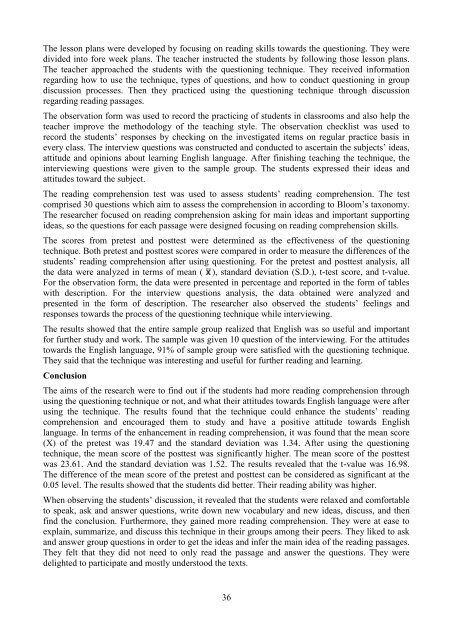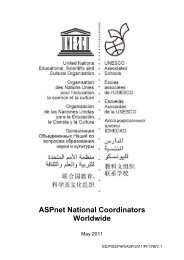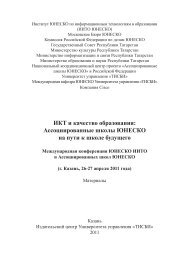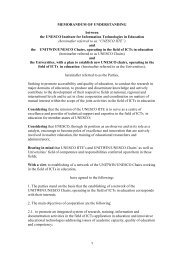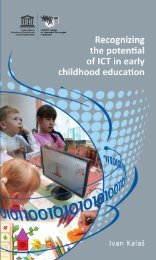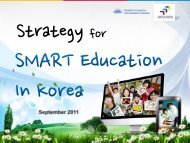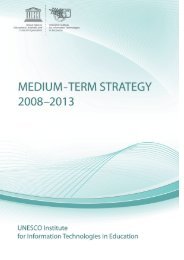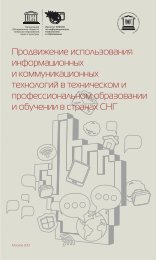eng - unesco iite
eng - unesco iite
eng - unesco iite
Create successful ePaper yourself
Turn your PDF publications into a flip-book with our unique Google optimized e-Paper software.
The lesson plans were developed by focusing on reading skills towards the questioning. They were<br />
divided into fore week plans. The teacher instructed the students by following those lesson plans.<br />
The teacher approached the students with the questioning technique. They received information<br />
regarding how to use the technique, types of questions, and how to conduct questioning in group<br />
discussion processes. Then they practiced using the questioning technique through discussion<br />
regarding reading passages.<br />
The observation form was used to record the practicing of students in classrooms and also help the<br />
teacher improve the methodology of the teaching style. The observation checklist was used to<br />
record the students’ responses by checking on the investigated items on regular practice basis in<br />
every class. The interview questions was constructed and conducted to ascertain the subjects’ ideas,<br />
attitude and opinions about learning English language. After finishing teaching the technique, the<br />
interviewing questions were given to the sample group. The students expressed their ideas and<br />
attitudes toward the subject.<br />
The reading comprehension test was used to assess students’ reading comprehension. The test<br />
comprised 30 questions which aim to assess the comprehension in according to Bloom’s taxonomy.<br />
The researcher focused on reading comprehension asking for main ideas and important supporting<br />
ideas, so the questions for each passage were designed focusing on reading comprehension skills.<br />
The scores from pretest and posttest were determined as the effectiveness of the questioning<br />
technique. Both pretest and posttest scores were compared in order to measure the differences of the<br />
students’ reading comprehension after using questioning. For the pretest and posttest analysis, all<br />
the data were analyzed in terms of mean ( ), standard deviation (S.D.), t-test score, and t-value.<br />
For the observation form, the data were presented in percentage and reported in the form of tables<br />
with description. For the interview questions analysis, the data obtained were analyzed and<br />
presented in the form of description. The researcher also observed the students’ feelings and<br />
responses towards the process of the questioning technique while interviewing.<br />
The results showed that the entire sample group realized that English was so useful and important<br />
for further study and work. The sample was given 10 question of the interviewing. For the attitudes<br />
towards the English language, 91% of sample group were satisfied with the questioning technique.<br />
They said that the technique was interesting and useful for further reading and learning.<br />
Conclusion<br />
The aims of the research were to find out if the students had more reading comprehension through<br />
using the questioning technique or not, and what their attitudes towards English language were after<br />
using the technique. The results found that the technique could enhance the students’ reading<br />
comprehension and encouraged them to study and have a positive attitude towards English<br />
language. In terms of the enhancement in reading comprehension, it was found that the mean score<br />
(X) of the pretest was 19.47 and the standard deviation was 1.34. After using the questioning<br />
technique, the mean score of the posttest was significantly higher. The mean score of the posttest<br />
was 23.61. And the standard deviation was 1.52. The results revealed that the t-value was 16.98.<br />
The difference of the mean score of the pretest and posttest can be considered as significant at the<br />
0.05 level. The results showed that the students did better. Their reading ability was higher.<br />
When observing the students’ discussion, it revealed that the students were relaxed and comfortable<br />
to speak, ask and answer questions, write down new vocabulary and new ideas, discuss, and then<br />
find the conclusion. Furthermore, they gained more reading comprehension. They were at ease to<br />
explain, summarize, and discuss this technique in their groups among their peers. They liked to ask<br />
and answer group questions in order to get the ideas and infer the main idea of the reading passages.<br />
They felt that they did not need to only read the passage and answer the questions. They were<br />
delighted to participate and mostly understood the texts.<br />
36


